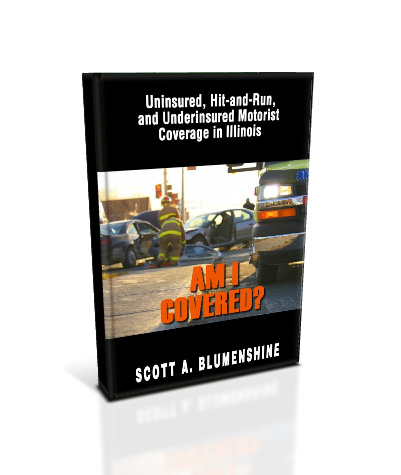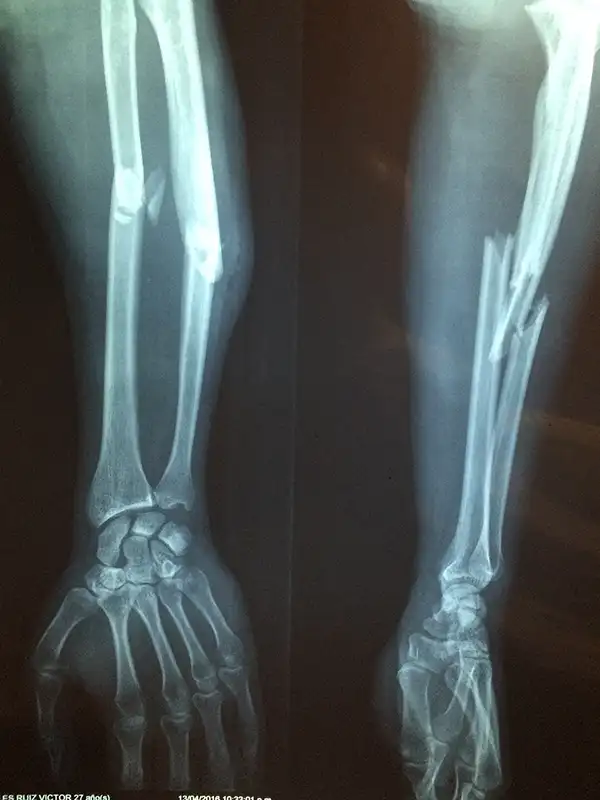The consequences of an accidental injury disrupt the victim’s life in many ways. The most anyone can hope for is that the injuries are not serious and recovery is quick. Broke bones are among the more serious results of an accident. Not only is the moment of the break painful, but the body part affected by the broken bone will more than likely require restricted movement until it can heal properly. The trauma of the bone break is balanced out with a generally positive prognosis for recovery, even if you require surgery, traction, or extended healing time. Loss of mobility can set you back financially because of medical treatment costs and loss of income while you recover. If you have broken bones due to the negligence of another, an attorney can help you set things right so you can make a full recovery.
Are you suffering from a broken bone due to someone else’s negligence? Let our skilled attorneys help you claim the compensation you deserve. Contact us now at (312)766-1000 for a consultation and take the first step towards financial recovery and peace of mind.
What is a Bone Fracture or Bone Break?
Bones are part of a complex musculoskeletal system network that allows our bodies to support themselves and move. Our bones are made of hard materials such as calcium and carbon, which provide a strong internal framework that protects our vital organs and supports us to move. Our bones can only provide so much protection against external forces and traumatic injuries such as falls or hard impacts; they can break, just like a stick or other rigid material. Unless the break is obvious, as with an open fracture that penetrates the skin, or a complete fracture that shows obvious misalignment, a doctor may need to perform an X-ray, MRI, or CT Scan to diagnose the break properly and know how to proceed with treatment.
How Common Are Bone Fractures?
Bone fractures are relatively common, with competitive sports, outdoor activities, and individual sports such as climbing or running leading the way as the most common cause. Many associate broken bones with childhood injuries since younger people are more often engaged in high-risk activities where broken bones are common. Bike riding, skateboarding, rock climbing, and sports such as football or soccer put broken bones at the top of the list for injuries. As we age, however, our bodies are more susceptible to breaks, which may be more severe and take longer to recover. Though we might not be playing sports and putting ourselves at risk for broken bones, something as simple as slipping on a wet floor or being in a car accident still puts us at risk for bone fractures. These accidents can happen almost anytime, not just on game day.
Types of Bone Fractures Caused by Accidents
Accidents result in particular kinds of breaks, which are indicative of sudden impact trauma. Here are some common types of fractures:
- Transverse: One of the more common breaks, the transverse, happens straight across the bone. It is typically a closed, stable fracture that may not require setting as the ends of the break are aligned and can heal with support and time on their own.
- Stress or Hairline fracture: This type of break may seem minor since it may even be challenging to diagnose with an X-ray, but it is no less painful and debilitating. These kinds of breaks are common with repetitive trauma, such as running, but may result from whiplash-type trauma.
- Spiral fracture: A more serious break, the division of the bone winds itself up and around the length of the bone in a spiral pattern. This type of break may need surgical aid to assist in healing, with pins, screws, and plates surgically implanted to support the bone as it heals.
- Oblique: Unlike a spiral fracture, this break does not run perpendicular to the grain of the bone and may be difficult to set.
- Greenstick: When the bone flexes but doesn’t make a clean break.
- Segmental or “Floating” fracture: When a long bone, such as you would find in your limbs or even ribs, breaks in multiple places, the section between breaks is detached from either end and may be very difficult to heal.
- Avulsion fracture: When the ligaments and tendons come under enough stress, they might exert enough force onto the bone to which they are attached to break it.
- Compression fracture: When forces on either end of the bones cause breakage due to crushing, this can cause a compression fracture or impact fracture. These breaks are very common in spinal injuries along the vertebrae, especially in older people or those with osteoporosis.
Common Bone Breaks or Fractures Due to Injury
Particular areas of the body are more susceptible to breaks than others due to accidents. In many ways, this shows that the musculoskeletal system is doing its job to protect critical parts of the body, but it can only do so much. Here are some fracture zones and injuries associated with them.
- Head Fractures: The skull protects the brain, critical parts of our body’s central nervous system, and perception areas like the eyes and sensory organs. But it can only do so much. Eye socket and nose fractures are common with vehicular accidents such as car and motorcycle crashes and impacts from objects falling from a great height as you would find at a construction zone. Skull fractures can also happen with a slip and fall injury if the head isn’t protected and strikes the ground.
- Neck and Back Fractures: Your spine comprises a series of vertebrae, which all work together to protect the spinal cord. These types of injuries are prevalent in whiplash injuries, falling from heights, and slip and fall injuries. Over time, compression injuries to the spine might also happen from work environments such as driving heavy equipment, excessive lifting, or even the use of a poorly designed chair or stool over long periods. Severe damage to any vertebrae can cause pain, paralysis, and permanent disability.
Broken Bones from Car Accidents
The forces involved in a car accident can come from just about any direction and are often sufficient to break the bone. Here are some different ways a car accident in Chicago might result in broken bones.
- Nasal Fracture: Even with airbags and seatbelts, nasal fractures are common in car accidents. Hitting the dashboard with your face or even a deploying airbag can break your nose, resulting in complex breakage and requiring surgery to reconstruct. A nasal fracture can impede your ability to breathe or speak. It can also result in chronic pain or affect your sense of smell. Nasal fractures can also result in infection, which could spread to your brain and be lethal if left untreated.
- Arm or leg fractures: Breaking an arm or a leg is all too common in a motor vehicle accident. Many drivers who are hurt in car accidents have broken legs from trying to apply pressure to the brake pedal. In contrast, defensive injuries can result from covering your face or bracing yourself for impact.
- Broken ribs: Our ribs protect our vital organs such as the heart, lungs, liver, and many other vulnerable systems. A car accident provides more than enough force to shatter ribs, however, leaving survivors with segmented fractures that are very hard to mend.
- Pelvic fractures: Our pelvis is one of the strongest bones in our body and also contains marrow, which builds white blood cells and fosters our immune systems. A pelvic fracture can be severe and result in blood clots and stroke if the marrow is released into the bloodstream. These types of injuries may require surgery, long periods of immobilization, and even cause permanent disability.
Broken Bones from Falls
Whether it is a fall from a great height or simply slipping on a wet or icy surface and hitting the ground, our bones protect our organs from these sorts of impacts as much as they can. Even still, falling can break bones, especially for the elderly or people with weakened bone density. If you have fallen and broken bones, an excellent injury attorney might be able to get you the compensation you deserve.
- Wrists: Attempting to break your fall can hyperextend your wrist and cause stress fractures in one or many bones that comprise your wrist.
- Long bones: In much the same way as you would break a wrist, long bones in your arm or leg can be broken from falls, especially in trying to brace yourself from the impact, as would be your natural reflex.
- Knees: Landing on your knee from a fall can shatter your patella or kneecap, which may require extensive surgery and a very long recovery time to heal.
- Skull fractures: Slipping and falling can result in cranial damage from standing height, as with a slip and fall injury.
- Pelvic: A broken hip or pelvis is a major concern to elderly people or those with degenerative bone disease such as osteoporosis. A broken pelvis from a fall can lead to complications and even be a life-changing event that shortens your lifespan by years.
Broken Bones in Workplace Accidents
Depending on your line of work, you may be at more risk than others in Chicago and Illinois for broken bones. Certain systems and training are required in dangerous environments such as construction sites and warehouses. Machinery used in assembly lines poses broken bone risks. Often, employers have taken shortcuts to save on the expense of providing adequate protective gear, signage, or training to limit injuries due to workplace accidents. Here are some common broken bones from workplace accidents:
- Skull injuries
- Spinal injuries
- Long bones: Arms, legs, fingers, ribs
- Crush injuries
- Falling from height
- Falls due to debris on walking surfaces
Medical Treatment and Complications From Broken Bones
Almost immediately after a break, our bodies will begin to heal the bone, just as with a cut or other injury. Due to the structure of our bones, they can break in many different ways, each requiring a different way to heal. Some breaks are more simple than others, with minor breaks requiring less attention than more complex broken bones. A stable fracture could require a splint or a cast, whereas an open or displaced fracture could break the skin and require resetting and surgery to allow the bone to heal properly.
Treatment options include:
- Traction: Whether the area is immobilized in the hospital with the help of a harness or at home with a cast and sling, keeping the area still and preventing movement as the bone mends is vital in healing a break. In the past, casts were common ways to provide traction during recovery, but now air splints and braces are the more acceptable practice.
- Pins and plates: With complex breaks, an orthopedic surgeon might need to reconstruct the broken area with the help of metal pins, wiring, or plates to hold the bone together properly so it can mend. These costly procedures require lengthy healing times and even physical therapy afterward.
- Physical therapy: Exercises, range of motion conditioning, and strength training are often used to ensure proper bone healing and eliminate the risk of deformity and disability.
- Time: The human body is very good at healing but still needs time. Over several weeks, the bone will heal but as you take care of your injury, you might miss time at work, lose future income, or fall behind on the medical bills that will start rolling in. A broken bones attorney can help you get the compensation you need for damage control to keep your life in order.
Complications
A bone break is very serious; even minor broken bone injuries can result in unexpected consequences. When in doubt, always consult your doctor if something doesn’t feel right. Your attorney should also be informed of any complications which may have arisen during your recovery.
- Metal allergies: Some patients may have a medical history of being allergic to certain metals used in reconstructive surgery, such as pins and plates. A nickel allergy, for example, may cause a systemic allergic reaction that may even cause infections or become fatal over long periods. These types of reactive metal may require removal and replacement with later surgeries to save the patient’s life.
- Pneumonia: Injuries from broken pelvic bones or ribs can lead to long periods of non-mobility, which can result in complications due to pneumonia in elderly patients.
- Infection: As with cuts or bruises, infection is always a concern. Most of the time, a closed fracture will heal independently, but displaced and open fractures allow pathogens to enter, resulting in infection. These kinds of breaks may require antibiotics, surgery, and possibly amputation to save the life of the patient.
How Long Does it Take to Heal From a Broken Bone?
Depending on the bone broken and the type of fracture, it can take as few as six weeks for the body to mend a broken bone. It may take several months, however, especially if surgery is required. Areas with continual use may take months to heal, such as knees and hip joints, or long bones, such as your femur, may take more time. Breaks that recover badly become permanently debilitating and affect your quality of life. You can’t know how long it takes to heal from a broken bone until completely healed. In the meantime, you could look at several months, and even years, of continued treatment, depending on the break.
FAQs
Here are some frequently asked questions about broken bones you might have.
What Compensation Could You Receive for an Injury?
Recovering from an accident can be a long and painful process. At the very least, these costs as you recover are going to be a drain on you and your family’s finances.
- Emergency medical care cost
- Surgery cost
- Hospitalization cost
- Physical therapy cost
- Pain management cost
- Loss of income (past and future)
- Pain and suffering (past and future)
- Disability: Partial or total (past and future)
What does a Chicago broken bones attorney do?
An attorney can help you negotiate a settlement to cover the expenses your injuries and treatment have incurred. They can present evidence to the insurer of the party responsible to leverage a higher settlement amount or present their evidence to a court of law if negotiations fail.
What Happens if I Break a Bone in an Accident and Don’t Have Insurance?
Many injuries are the result of someone else’s negligence. A slippery spot on a grocery store floor, a car that has run a red light and hit you, a workplace that hasn’t provided safety equipment, and many others can result in broken bones. These events weren’t your fault, and those responsible must be held accountable. A broken bones attorney can help you sue for damages to recover the cost of these injuries and treatment from those at fault.
How long will my case take?
No simple answer can be honestly given on how long a broken bones case might take. We can honestly promise our practice system to move your case to a conclusion. With continued treatment of your injury, combined with a projected estimate of any long-term effects such as disability or more surgeries, you need time not only to mend but also to see how much is going to be needed to cover your bills. A settlement with an insurance company could take several weeks and upwards of years, depending on the severity of your injuries.
Contact the Blumenshine Law Group for a Free Consultation
While you recover from a broken bone or bones, you might feel physically, emotionally, and financially vulnerable. You might be tempted to accept any offer an insurance company gives you to avoid the stress of the whole process. Insurance companies know this and often prey on the vulnerable. In most cases, a dedicated, talented attorney fights for their injured client, resulting in higher settlement amounts. You will also benefit from an experienced, savvy lawyer who will counsel and advocate for you. This can go a long way to alleviating the legal process’s stress and ensuring your rights are protected. Call or text us today at (312)766-1000 or email [email protected] to see how we can help you heal.




